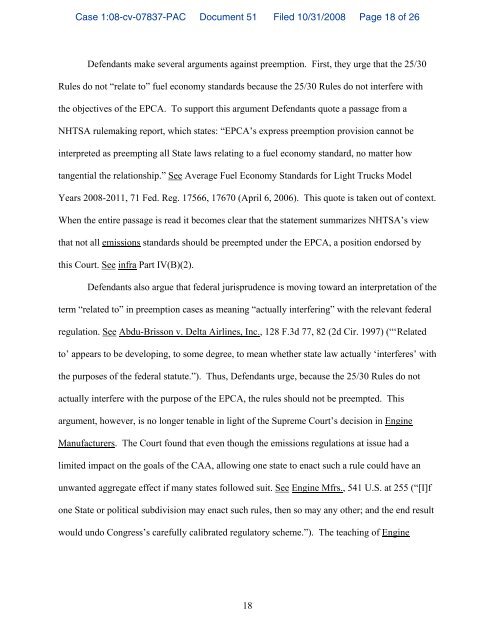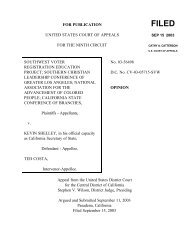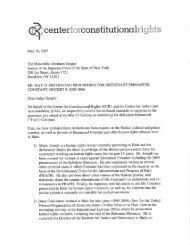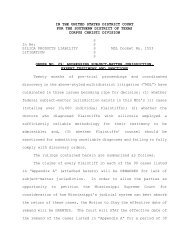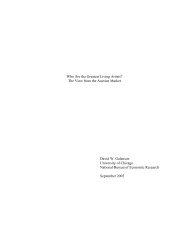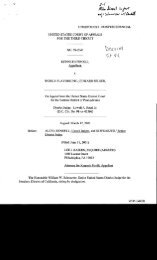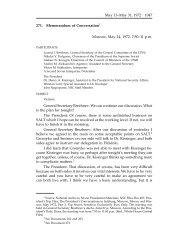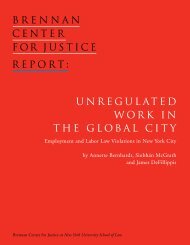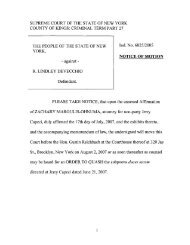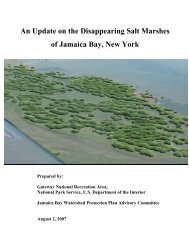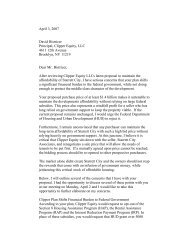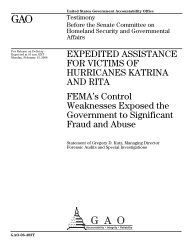UNITED STATES DISTRICT COURT SOUTHERN DISTRICT OF ...
UNITED STATES DISTRICT COURT SOUTHERN DISTRICT OF ...
UNITED STATES DISTRICT COURT SOUTHERN DISTRICT OF ...
Create successful ePaper yourself
Turn your PDF publications into a flip-book with our unique Google optimized e-Paper software.
Case 1:08-cv-07837-PAC Document 51 Filed 10/31/2008 Page 18 of 26<br />
Defendants make several arguments against preemption. First, they urge that the 25/30<br />
Rules do not “relate to” fuel economy standards because the 25/30 Rules do not interfere with<br />
the objectives of the EPCA. To support this argument Defendants quote a passage from a<br />
NHTSA rulemaking report, which states: “EPCA’s express preemption provision cannot be<br />
interpreted as preempting all State laws relating to a fuel economy standard, no matter how<br />
tangential the relationship.” See Average Fuel Economy Standards for Light Trucks Model<br />
Years 2008-2011, 71 Fed. Reg. 17566, 17670 (April 6, 2006). This quote is taken out of context.<br />
When the entire passage is read it becomes clear that the statement summarizes NHTSA’s view<br />
that not all emissions standards should be preempted under the EPCA, a position endorsed by<br />
this Court. See infra Part IV(B)(2).<br />
Defendants also argue that federal jurisprudence is moving toward an interpretation of the<br />
term “related to” in preemption cases as meaning “actually interfering” with the relevant federal<br />
regulation. See Abdu-Brisson v. Delta Airlines, Inc., 128 F.3d 77, 82 (2d Cir. 1997) (“‘Related<br />
to’ appears to be developing, to some degree, to mean whether state law actually ‘interferes’ with<br />
the purposes of the federal statute.”). Thus, Defendants urge, because the 25/30 Rules do not<br />
actually interfere with the purpose of the EPCA, the rules should not be preempted. This<br />
argument, however, is no longer tenable in light of the Supreme Court’s decision in Engine<br />
Manufacturers. The Court found that even though the emissions regulations at issue had a<br />
limited impact on the goals of the CAA, allowing one state to enact such a rule could have an<br />
unwanted aggregate effect if many states followed suit. See Engine Mfrs., 541 U.S. at 255 (“[I]f<br />
one State or political subdivision may enact such rules, then so may any other; and the end result<br />
would undo Congress’s carefully calibrated regulatory scheme.”). The teaching of Engine<br />
18


